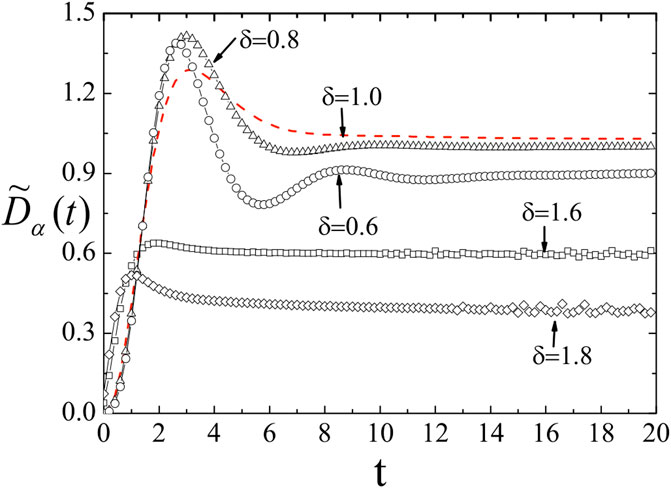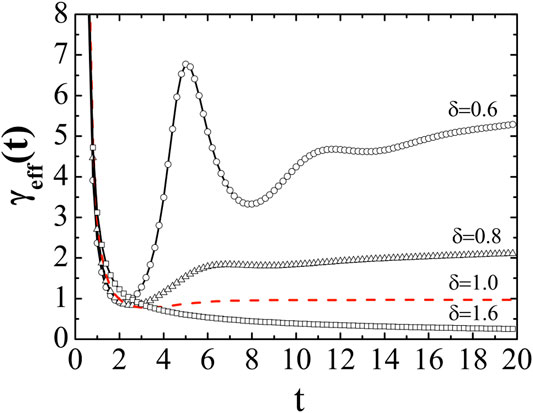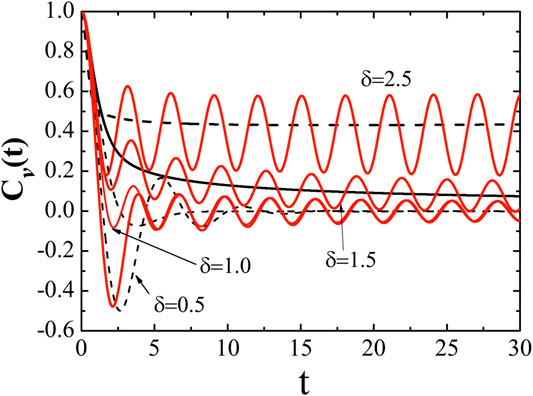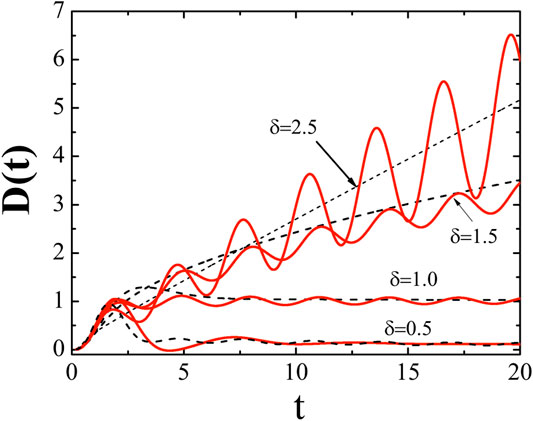- Department of Physics, Beijing Normal University, Beijing, China
The precise determination of diffusive properties is presented for a system described by the generalized Langevin equation. The time-dependent fractional diffusion function and the Green-Kubo relation as well as the generalized Stokes-Einstein formula, in the spirit of ensemble averages, are reconfigured. The effective friction function is introduced as a measure of the influence of frequency-dependent friction on the evolution of the system. This is applied to the generalized Debye model, from which self-oscillation emerges as indicative of ergodicity that breaks due to high finite-frequency cutoff. Moreover, several inconsistent conclusions that have appeared in the literature are revised.
1 Introduction
In the early 20th century, Brownian motion became the subject of a theoretical investigation by Einstein, Langevin, Smoluchowski, and others [1–3]. The well-known conclusion was that the mean squared displacement of a force-free particle grows linearly in time. Because the Brownian trajectories were relatively short, Jean Perrin in 1908 used an ensemble average over many particle traces to obtain meaningful statistics. A few years later, Ivar Nordlune conceived a method for recording much longer time series. This let him determine time average individual trajectories and thus avoid average ensembles of particles that were probably not identical [3]. The average can be understood either as an ensemble average over a large number of trajectories or as a temporal moving average over a very long time trajectory. Nevertheless, the time average diffusion coefficient might be a random variable different from that of the ensemble, albeit the measurement time is long [4–6]. Since the ergodicity is broken in this sense, the diffusion coefficient can only be calculated by using the ensemble average. In theory, one mostly considers ensemble average; in the experiment, however, it is sometimes the former that taken the place of time averages because only one realization of a process is recorded. For an ergodic system, the time average is the same as the ensemble average [7]. The ensemble averaging result can be regarded as a comparable criterion.
Superseding Einstein’s theory of Brownian movement, anomalous diffusion is characterized by the variance of the position of a diffusing particle increasing with time in a power-law form [8–11]. From an analysis of experimental data, the variance of the position for a force-free particle may be written in scalar form,
where
There are many formalisms that describe anomalous diffusion, and growing interest has gathered around using the generalized Langevin equation (GLE) [14–16] as a viable alternative for investigating anomalous diffusion. One of the key features of the GLE is that it contains an after-effect function, termed a memory function [17, 18], which can be obtained from experiments or molecular dynamics simulations [19, 20]. Previous works on anomalous diffusion using the non-Ohmic friction model without high-frequency decay modulation showed that the VACF varies with time governed by the Mittag-Leffler function [21–25]. Indeed, a little transitive friction information can be extracted, although one knows that the diffusion coefficient determined by standard approaches vanishes for subdiffusion and diverges for superdiffusion. Furthermore, the issue of long-term memory [26] is always of central importance in nonequilibrium statistical mechanics, but there are several grounds for doubt [27], e.g., the dynamical effect related to the sharp cutoff in the spectrum being widely used, that require clarification.
The purpose of this paper is to set the diffusion coefficient and scaling exponent for anomalous diffusion processes; in particular, we will introduce another quantity, the effective friction function related to non-Stokesian relaxation, to account for the after-effect of anomalous diffusion. A measurement of this function does not present major difficulties for experiments yet provides a novel characterization of the underlying evolutionary process. The following questions also arise: What forms do the generalized Green-Kubo and Stokes-Einstein relations take in regard to anomalous diffusion? Can the coefficient of diffusion and the exponent be measured accurately? How strong is the effect of the high finite-frequency cutoff on the dynamics? The answers will become clear in the present study.
2 Relations Between Various Temporal Functions
2.1 Time-Dependent Fractional Diffusion Function
To extract the pre-time coefficient
where
where
2.2 Generalization of Two Famous Statistical-Dynamics Relations
The motion of a particle driven by a Gaussian distributed noise
where
When the external potential is absent, i.e., when dealing with free diffusive motion, the formal solution of Eq. 4 is obtained by means of the Laplace-transform technique [35–38], which yields
The sum of the first three terms represents the square of the average position, and the sum of the latter two terms is the position variance. Note that the position variance is independent of the initial preparation of the particle.
We have found that the time-dependent diffusion functions, calculated by taking the time-derivative of the position variance and the MSD, are different. If the particle is confined initially at the origin
Therefore, the diffusion function obtained by differentiating Eq. 6 yields
This expression is valid for anomalous diffusion and nonergodic processes as well as for arbitrary initial preparations. Equation 7 is referred to as the generalized time-dependent Kubo relation. In particular, under the condition
The standard Stokes-Einstein expression that has just been reviewed applies to steady motion only and should be regarded as a zero-frequency theory. It is not consistent with using a coefficient of friction derived assuming steady motion describing changes in velocity. For this reason, the generalization of the Stokes-Einstein formula for an arbitrary frequency is of interest. For a broad class of systems, relaxation into the stationary state is exponentially fast; however, this is not true for all physical systems. Some systems may possess a stationary process, but the relaxation toward this state may be slow, and the well-known Stokes-Einstein formula thus needs to be generalized more. For anomalous diffusion, with a stationary VACF, the limiting result of the ratio of the time-dependent diffusion function to the velocity relaxation time, we report a generalized Stokes-Einstein relation:
Here
In fact, Eq. 8 involves a spectral result [19],
2.3 Typical Long-Range Memory
We now consider a generic noise spectral density (NSD) generated by a model for non-Ohmic friction [21, 22], for which the memory function takes the form
where
In Figure 1, we plot the time-dependent fractional diffusion function calculated numerically using Eq. 3 combined with Eqs 7,9. All values of quantities used here on in are stated in dimensionless form, (i.e.

FIGURE 1. Time-dependent fractional diffusion function calculated using Eq. 3 for various known values of the exponents δ. Here,
3 Effective Friction Function
3.1 Self-Consistent Extraction
More importantly, we want to introduce the temporal effective friction function, which is extracted consistently from Eq. 7 by assuming
Starting from experimental sampling of the velocities of tagged particles with injection velocity
An effective friction function that depends on both the physical features and the underling process is then defined,
The advantage of this approach is that the entire configurational details are reduced to the particle’s velocity, which is easily measured. Theoretically, it is easier to discuss a double average, one over time and the other over the ensemble of different trajectories.
For example, for the Ohmic friction
where
Figure 2 shows the time-dependent effective friction function for various δ. It starts from infinity because the system does not yet receive any dissipative energy from its environment at the initial time. This function approaches a constant value for normal diffusion, i.e., the low-frequency Markovian friction strength

FIGURE 2. Effective friction function calculated from the non-Ohmic friction model for various δ. Here
4 SELF-OSCILLATION Diffusion
4.1 Determination of Diffusive Exponent
Lastly, the thorny problem is the measurement of the power-law exponent α from observed data. Of note is the fact that if
where
4.2 The Effect of High-Frequency Cutoff
In contrast to usual understanding, the notion of the effective friction function proposed here is dependent on underlying processes rather than the static result. It is concluded from Figure 2, (e.g., the comparison between solid and dashed lines when
Nevertheless, the first choice in Eq. 9 cannot be adopted when
The Laplace transform of the memory function for the non-Ohmic friction model combining with
where
where
According to the Khinchin theorem, if
and the residues do not equal zero at these poles. The second term on the l.h.s of Eq. 17 is the Laplace transform of the memory function. We report also an alternative NSD, which can induce nonergodicity of three types, i.e.,
where
Applying the residue theorem [47, 48], we obtain a general result for the velocity relaxation function,
where
The quantity is equal to a constant less than unity as long as
Clearly, the upper-limit of the summation in Eq. 19 may be infinity because
For a complex variable s, we have
Figure 3 shows the resulting VACF for various δ and two different modulation functions of the frequency. Evidently, there exist three types of nonergodicity where the VACF 1) approaches a positive constant, 2) oscillates with time around a plateau value, or 3) oscillates with time around zero; the simple conditions satisfied by the NSD are low-hindering, band-passing, and high-hindering or band-hindering. This forces the ensemble to become unstable, although the GLE used is initially stationary. The oscillation implies that the particle tends to reverse its direction of motion frequently relative to its former step. This classification of the nonergodic behavior may be regarded as a probe of a more precise estimation of the low and high frequencies distribution for thermal colored noise. In addition, from the microscopic Hamiltonian viewpoint, ergodicity breakage is caused by a localized mode with an isolated frequency from the continued phonon spectrum [46, 49].

FIGURE 3. VACF for various exponents δ using the non-Ohmic friction model with
In Figure 4, we plot the time-dependent diffusion function for various situations and show the diffusion function oscillating with time. Because the diffusion function produced carries out a time derivative over the MSD, the whole approach [Eq. 14] rather than a local differential method must be used to determine the power-law exponent of diffusion. Many models may induce such a phenomenon, and several famous examples have been mentioned before. A somewhat surprising result for us is that the system associated with the Debye frequency-cutoff does not yield ergodic behavior.

FIGURE 4. Diffusion function for various exponents δ using the non-Ohmic friction model. The corresponding situations and parameter settings used are the same as in Figure 3.
5 Summary
This work aims at furnishing a connection between velocity autocorrelation function (VACF) and frictional kernel in the generalized Langevin equation (GLE) framework for the diffusion dynamics. On the one hand, the VACF is a quantity that can be obtained from experimental or numerical data; on the other hand, the friction kernel incorporates the noise correlation properties. However, this relation is hard to achieve by analytical means, and we thus introduce an effective friction function that depends solely on the VACF and is supposed to inform on the retarded memory effects on the dynamics. The notion of effective friction function has been observed as an echo of the non-Markovian Brownian motion, which is associated with the diffusion function and is measured through a tagged particle’s average velocity. This provides interesting information regarding the evolution of kinetics. We have obtained alternative time-dependent Green-Kubo and generalized Stokes-Einstein relations to universal situations connected with anomalous diffusion and nonergodic processes. The effect of finite or high-frequency cutoff as a facile method on the dynamics is numerically investigated. A self-oscillation phenomenon emerges as a manifestation of ergodicity breakdown. In particular, several inconsistent conclusions in the literature, e.g., the analysis requirement of susceptibility, the friction feature extracted by the generalized Fokker-Planck equation, and the power-law exponent obtained from data, have been clarified. We are also confident that the present results will serviceably impact complex dissipative systems.
Data Availability Statement
The original contributions presented in the study are included in the article/Supplementary Material, further inquiries can be directed to the corresponding author.
Author Contributions
The author confirms being the sole contributor of this work and has approved it for publication.
Funding
This work was supported by the National Natural Science Foundation of China under Grant No. 11735005.
Conflict of Interest
The author declares that the research was conducted in the absence of any commercial or financial relationships that could be construed as a potential conflict of interest.
Appendix
The Friction Function in GFPE
An important application concerns non-Markovian Brownian motion within fluctuating hydrodynamics with a non-Stokesian drag having a power-law VACF, i.e.,
where the friction function was defined by
It is found to be valid only when the memory kernel is a delta function. Moreover, if
In addition, Adelman [51] ignored the inertia and then defined the diffusion function as
References
1. Einstein A. Investigations on the theory of the brownian movement New York, NY, United States: Dover (1956).
2. Hänggi P., Marchesoni F. Introduction: 100 years of brownian motion. Chaos (2005) 15:26101. doi:10.1063/1.1895505
3. Barkai E., Garini Y., Metzler R. Strange kinetics of single molecules in living cells. Phys Today (2012) 65(8):29. doi:10.1063/pt.3.1677
4. He Y., Burov S., Metzler R., Barkai E. Random time-scale invariant diffusion and transport coefficients. Phys Rev Lett (2008) 101:058101. doi:10.1103/PhysRevLett.101.058101
5. Lubelski A., Sokolov I. M., Klafter J. Nonergodicity mimics inhomogeneity in single particle tracking. Phys Rev Lett (2008) 100:250602. doi:10.1103/PhysRevLett.100.250602
6. Burov S., Metzler R., Barkai E. Aging and nonergodicity beyond the Khinchin theorem. Proc Natl Acad Sci United States (2010) 107:13228. doi:10.1073/pnas.1003693107
7. Meyer P., Barkai E., Kantz H. Scale-invariant Green-Kubo relation for time-averaged diffusivity. Phys. Rev. E. E (2017) 96:062122. doi:10.1103/PhysRevE.96.062122
8. Metzler R., Klafter J. The random walk's guide to anomalous diffusion: a fractional dynamics approach. Phys. Rep (2000) 339:1–17. doi:10.1016/s0370-1573(00)00070-3
9. Thiel F., Flegel F., Sokolov I. M. Disentangling sources of anomalous diffusion. Phys. Rev. Lett (2013) 111:010601. doi:10.1103/PhysRevLett.111.010601
10. Flekkøy E. G. Minimal model for anomalous diffusion. Phys. Rev. E. E (2017) 95:012139. doi:10.1103/PhysRevE.95.012139
11. Sokolov I. M. Models of anomalous diffusion in crowded environments. Soft Matter (2012) 8:9043. doi:10.1039/c2sm25701g
12. Boon J. P., Yip S., Hansen J. P. Moclecular hydrodynamics 1986 In: McDonald IR. Theory of simple liquids New York, NY, United States: McGraw-HillAcademic (1980)
13. Dechant A., Lutz E., Kessler D. A., Barkai E. Scaling Green-Kubo relation and application to three aging systems. Phys. Rev. E. X (2014) 4:011022. doi:10.1103/physrevx.4.011022
14. Mori H. A quantum-statistical theory of transport processes. J. Phys. Soc. Jpn (1956) 11:1029. doi:10.1143/jpsj.11.1029
15. Mori H. Transport, collective motion, and Brownian motionA continued-fraction representation of the time-correlation function. Prog. Theor. Phys (1965) 34:399–416. doi:10.1143/ptp.34.399
16. Zwanzig R. Nonlinear generalized Langevin equations. J. Stat. Phys (1973) 9:215. doi:10.1007/bf01008729
17. Sagnlla D. E., Straub J. E., Thirumalai D. Time scales and pathways for kinetic energy relaxation in solvated proteins: application to carbonmonoxy myoglobin. J. Chem. Phys (2000) 113:7702. doi:10.1063/1.1313554
18. Mokshin A. V., Yulmetyev R. M., Hänggi P. Simple measure of memory for dynamical processes described by a generalized Langevin equation. Phys. Rev. Lett (2005) 95:200601. doi:10.1103/PhysRevLett.95.200601
19. Sanghi T., Bhadauria R., Aluru N. R. Memory effects in nanoparticle dynamics and transport. J. Chem. Phys (2016) 145:134108. doi:10.1063/1.4964287
20. Shin H. K., Choi B., Talkner P., Lee E. K. Normal versus anomalous self-diffusion in two-dimensional fluids: memory function approach and generalized asymptotic Einstein relation. J. Chem. Phys (2014) 141:214112. doi:10.1063/1.4902409
22. Pottier N. Aging properties of an anomalously diffusion particule. Physica. A (2004) 291:371–82. doi:10.1016/S0378-4371(02)01361-4
23. Barkai E., Silbey R. J. Fractional kramers equation†. J. Phys. Chem. B (2000) 104:3866. doi:10.1021/jp993491m
24. Kneller G. R. Communication: a scaling approach to anomalous diffusion. J. Chem. Phys (2014) 141:041105. doi:10.1063/1.4891357
25. Stachura S., Kneller G. R. Communication: probing anomalous diffusion in frequency space. J. Chem. Phys (2015) 143:191103. doi:10.1063/1.4936129
26. Hänggi P., Grabert H., Ingold G. L., Weiss U. Quantum theory of activated events in presence of long-time memory. Phys. Rev. Lett (1985) 55:761. doi:10.1103/PhysRevLett.55.761
27. Srokowski S. Nonstationarity induced by long-time noise correlations in the Langevin equation. Phys. Rev. Lett (2000) 85:2232. doi:10.1103/PhysRevLett.85.2232
28. Kubo R., Toda M., Hashitsume N. Statistical Physics II, nonequilibrium statistical mechanics 2nd ed. Berlin, Germany: Springer-Verlag (1991)
29. Marchesoni F., Taloni A. Subdiffusion and long-time anticorrelations in a stochastic single file. Phys. Rev. Lett (2006) 97:106101. doi:10.1103/PhysRevLett.97.106101
30. Bao J. D., Zhuo Y. Z. Ballistic diffusion induced by a thermal broadband noise. Phys. Rev. Lett (2003) 91:138104. doi:10.1103/PhysRevLett.91.138104
31. Pereira A. P. P., Fernandes J. P., Atman A. P. F., Acebal J. L. Parameter calibration between models and simulations: connecting linear and non-linear descriptions of anomalous diffusion. Phys Stat Mech Appl (2018) 509:369. doi:10.1016/j.physa.2018.06.025
32. Ford G. W., Lewis J. T., O’Connell R. F. Quantum Langevin equation. Phys. Rev. A. Gen. Phys (1988) 37:4419. doi:10.1103/physreva.37.4419
33. Bao J. D. Generalization of the Kubo relation for confined motion and ergodicity breakdown. Phys. Rev. E. E (2020) 101:062131. doi:10.1103/PhysRevE.101.062131
34. Ferrari L. Test particles in a gas: Markovian and non-Markovian Langevin dynamics. Chem. Phys (2019) 523:42. doi:10.1016/j.chemphys.2019.03.011
35. Mazo R. M. In: L. Garrido, P. Seglar, and P. J. Shepherd, editors. Stochastic processes in nonequilibrium systems New York, NY, United States: Springrt-Verlag (1965)
36. Porr J. M., Wang K. G., Masoliver J. Generalized Langevin equations: anomalous diffusion and probability distributions. Phys Rev E: Stat Phys, Plasmas, Fluids, Relat Interdiscip Top (1996) 53:5872. doi:10.1103/physreve.53.5872
37. Taloni A., Lomholt M. A. Langevin formulation for single-file diffusion. Phys. Rev. E. Stat. Nonlin Soft Matter Phys (2008) 78:051116. doi:10.1103/PhysRevE.78.051116
38. Bao J.-D. Non-Markovian two-time correlation dynamics and nonergodicity. J. Stat. Phys (2017) 168:561. doi:10.1007/s10955-017-1815-x
39. Bao J. D., Hänggi P., Zhuo Y. Z. Non-Markovian Brownian dynamics and nonergodicity. Phys. Rev. E. Stat. Nonlin Soft Matter Phys (2005) 72:061107. doi:10.1103/PhysRevE.72.061107
40. Bao J. D., Zhuo Y. Z., Oliveira F. A., Hänggi P. Intermediate dynamics between Newton and Langevin. Phys. Rev. E. Stat. Nonlin Soft Matter Phys (2006) 74:061111. doi:10.1103/PhysRevE.74.061111
41. Spiechowicz J., Hänggi P., Łuczka J. Coexistence of absolute negative mobility and anomalous diffusion. New J. Phys (2019) 21:083029. doi:10.1088/1367-2630/ab3764
42. Lee M. H. Why irreversibility is not a sufficient condition for ergodicity. Phys. Rev. Lett (2007) 98:190601. doi:10.1103/PhysRevLett.98.190601
43. Lapas L. C., Morgado R., Vainstein M. H., Rubí J. M., Oliveira F. A. Khinchin theorem and anomalous diffusion. Phys. Rev. Lett (2008) 101:230602. doi:10.1103/PhysRevLett.101.230602
44. Oliveira F. A., Ferreira R. M. S., Lapas L. C., Vainstein M. H. Anomalous diffusion: a basic mechanism for the evolution of inhomogeneous systems. Front. Physiol (2019) 7:18. doi:10.3389/fphy.2019.00018
45. Kim J., Sawada I. Dynamics of a harmonic oscillator on the Bethe lattice. Phys. Rev. E. E (2000) 61:R2172. doi:10.1103/physreve.61.r2172
46. Ishikawa F., Todo S. Localized mode and nonergodicity of a harmonic oscillator chain. Phys. Rev. E. E (2018) 98:062140. doi:10.1103/physreve.98.062140
47. Muralidhar R., Jacobs D. J., Ramkrishna D., Nakanishi H. Diffusion on two-dimensional percolation clusters: influence of cluster anisotropy. Phys. Rev. A (1991) 43:6503. doi:10.1103/physreva.43.6503
48. Bao J. D. Generalized Einstein relations and conditions for anomalous relaxation. Phys. Rev. E. E (2019) 100:052149. doi:10.1103/PhysRevE.100.052149
49. Qiu Q., Shi X. Y., Bao J. D. Mixed nonergodicity of a forced system and its non-stationary strength. Europhys. Lett (2019) 128:2005. doi:10.1209/0295-5075/128/20005
50. Fox R. F. The generalized Langevin equation with Gaussian fluctuations. J. Math Phys (1977) 18:2331. doi:10.1063/1.523242
51. Adelman S. A. Fokker-Planck equations for simple non‐Markovian systems. J. Chem. Phys (1976) 64:124. doi:10.1063/1.431961
Keywords: anomalous diffusion, fractional diffusion function, friction function, nonergodicity, debye model, oscillation
Citation: Bao J-D (2021) Time-Dependent Fractional Diffusion and Friction Functions for Anomalous Diffusion. Front. Phys. 9:567161. doi: 10.3389/fphy.2021.567161
Received: 29 May 2020; Accepted: 05 January 2021;
Published: 19 February 2021.
Edited by:
Fernando A. Oliveira, University of Brasilia, BrazilReviewed by:
Alessandro Taloni, National Research Council (CNR), ItalyAllbens Picardi Faria Atman, Federal Center for Technological Education of Minas Gerais, Brazil
Copyright © 2021 Bao. This is an open-access article distributed under the terms of the Creative Commons Attribution License (CC BY). The use, distribution or reproduction in other forums is permitted, provided the original author(s) and the copyright owner(s) are credited and that the original publication in this journal is cited, in accordance with accepted academic practice. No use, distribution or reproduction is permitted which does not comply with these terms.
*Correspondence: Jing-Dong Bao, amRiYW9AYm51LmVkdS5jbg==
 Jing-Dong Bao
Jing-Dong Bao